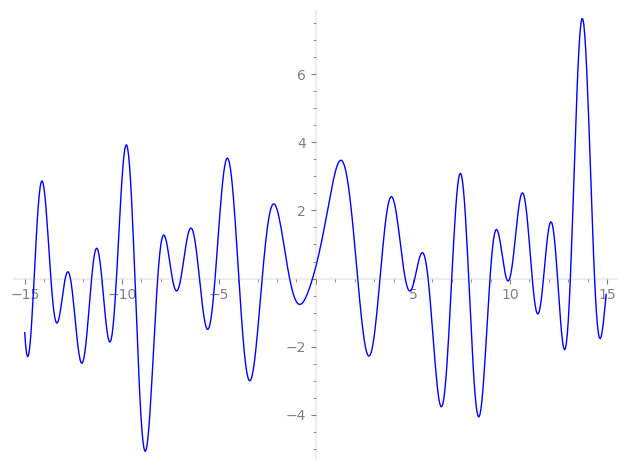| L(s) = 1 | + (−1.14 − 1.98i)3-s + (−0.175 + 0.303i)5-s + (−0.303 − 2.62i)7-s + (−1.11 + 1.93i)9-s + (−1.55 − 2.69i)11-s − 3.97·13-s + 0.801·15-s + (1.35 + 2.33i)17-s + (0.341 − 0.591i)19-s + (−4.86 + 3.61i)21-s + (2.05 − 3.56i)23-s + (2.43 + 4.22i)25-s − 1.74·27-s − 6.74·29-s + (−0.232 − 0.402i)31-s + ⋯ |
| L(s) = 1 | + (−0.660 − 1.14i)3-s + (−0.0782 + 0.135i)5-s + (−0.114 − 0.993i)7-s + (−0.373 + 0.646i)9-s + (−0.468 − 0.812i)11-s − 1.10·13-s + 0.206·15-s + (0.327 + 0.567i)17-s + (0.0783 − 0.135i)19-s + (−1.06 + 0.787i)21-s + (0.429 − 0.743i)23-s + (0.487 + 0.844i)25-s − 0.335·27-s − 1.25·29-s + (−0.0417 − 0.0723i)31-s + ⋯ |
\[\begin{aligned}\Lambda(s)=\mathstrut & 1148 ^{s/2} \, \Gamma_{\C}(s) \, L(s)\cr =\mathstrut & (-0.645 - 0.763i)\, \overline{\Lambda}(2-s) \end{aligned}\]
\[\begin{aligned}\Lambda(s)=\mathstrut & 1148 ^{s/2} \, \Gamma_{\C}(s+1/2) \, L(s)\cr =\mathstrut & (-0.645 - 0.763i)\, \overline{\Lambda}(1-s) \end{aligned}\]
Particular Values
| \(L(1)\) |
\(\approx\) |
\(0.3608726238\) |
| \(L(\frac12)\) |
\(\approx\) |
\(0.3608726238\) |
| \(L(\frac{3}{2})\) |
|
not available |
| \(L(1)\) |
|
not available |
\(L(s) = \displaystyle \prod_{p} F_p(p^{-s})^{-1} \)
| $p$ | $F_p(T)$ |
|---|
| bad | 2 | \( 1 \) |
| 7 | \( 1 + (0.303 + 2.62i)T \) |
| 41 | \( 1 - T \) |
| good | 3 | \( 1 + (1.14 + 1.98i)T + (-1.5 + 2.59i)T^{2} \) |
| 5 | \( 1 + (0.175 - 0.303i)T + (-2.5 - 4.33i)T^{2} \) |
| 11 | \( 1 + (1.55 + 2.69i)T + (-5.5 + 9.52i)T^{2} \) |
| 13 | \( 1 + 3.97T + 13T^{2} \) |
| 17 | \( 1 + (-1.35 - 2.33i)T + (-8.5 + 14.7i)T^{2} \) |
| 19 | \( 1 + (-0.341 + 0.591i)T + (-9.5 - 16.4i)T^{2} \) |
| 23 | \( 1 + (-2.05 + 3.56i)T + (-11.5 - 19.9i)T^{2} \) |
| 29 | \( 1 + 6.74T + 29T^{2} \) |
| 31 | \( 1 + (0.232 + 0.402i)T + (-15.5 + 26.8i)T^{2} \) |
| 37 | \( 1 + (-2.16 + 3.75i)T + (-18.5 - 32.0i)T^{2} \) |
| 43 | \( 1 + 2.58T + 43T^{2} \) |
| 47 | \( 1 + (2.98 - 5.16i)T + (-23.5 - 40.7i)T^{2} \) |
| 53 | \( 1 + (1.02 + 1.77i)T + (-26.5 + 45.8i)T^{2} \) |
| 59 | \( 1 + (-5.19 - 8.99i)T + (-29.5 + 51.0i)T^{2} \) |
| 61 | \( 1 + (1.43 - 2.48i)T + (-30.5 - 52.8i)T^{2} \) |
| 67 | \( 1 + (-1.57 - 2.73i)T + (-33.5 + 58.0i)T^{2} \) |
| 71 | \( 1 + 3.23T + 71T^{2} \) |
| 73 | \( 1 + (-0.299 - 0.519i)T + (-36.5 + 63.2i)T^{2} \) |
| 79 | \( 1 + (-0.428 + 0.741i)T + (-39.5 - 68.4i)T^{2} \) |
| 83 | \( 1 + 12.9T + 83T^{2} \) |
| 89 | \( 1 + (7.01 - 12.1i)T + (-44.5 - 77.0i)T^{2} \) |
| 97 | \( 1 + 3.40T + 97T^{2} \) |
| show more | |
| show less | |
\(L(s) = \displaystyle\prod_p \ \prod_{j=1}^{2} (1 - \alpha_{j,p}\, p^{-s})^{-1}\)
Imaginary part of the first few zeros on the critical line
−9.320368506169859017101659634362, −8.149231741628005708465903065447, −7.39297496828025073072924536687, −6.95849830886394662774008019905, −5.99596425726246218262138561203, −5.19480247705224007623267049168, −3.96608434736036853070496311734, −2.76772984141577484624884156794, −1.35263157155491292801029102833, −0.17418906588250577782032105198,
2.15318299690821275192113157721, 3.30152281784824676285943903270, 4.60335375683832797618237715872, 5.09281574074344574275381920920, 5.77884260902378465315340271804, 6.99617080134691502388142342763, 7.87172159659094218637096036554, 8.967440062943715180069868302368, 9.814327078611391484069599731381, 9.982239692366080793270199349521

